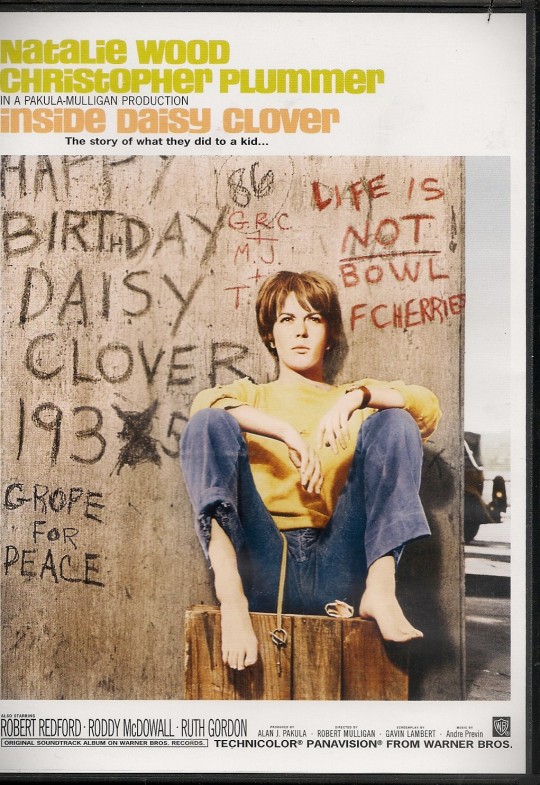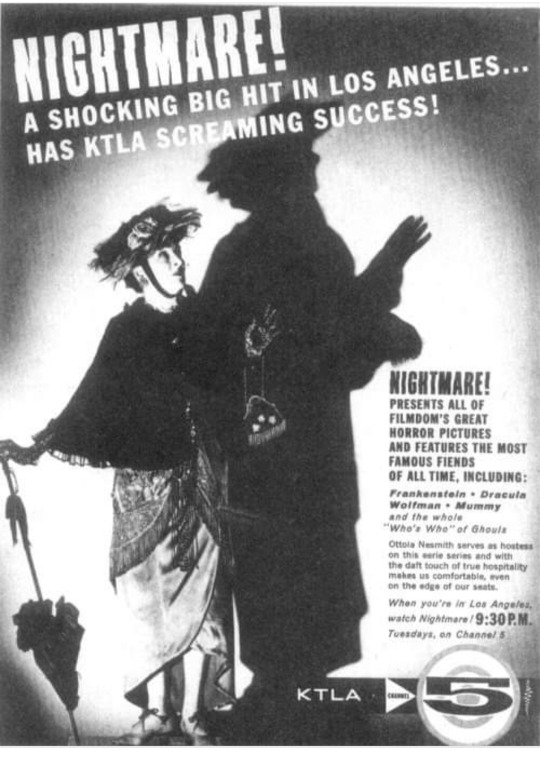#Ottola Nesmith
Text
Return of the Vampire 1943
Bela Lugosi










Unofficial follow-up to the 1931 Dracula movie. The movie was produced by Columbia Pictures and not Universal. This is the last time Lugosi was to receive top billing by any major Hollywood Studio.
2 notes
·
View notes
Text

Bad movie I have Inside Daisy Clover 1965
#Inside Daisy Clover#Natalie Wood#Christopher Plummer#Robert Redford#Ruth Gordon#Roddy McDowall#Katharine Bard#Peter Helm#Betty Harford#John Hale#Harold Gould#Ottola Nesmith#Edna Holland#John Barrymore#Humphrey Bogart#John Breen#Boyd Cabeen#Dee Carroll#Fred Curt#John Philip Dayton#Gertrude Flynn#Clark Gable#Merv Griffin#Jack Harmon#Sonja Henie#Shep Houghton#Carole Lombard#Myrna Loy#Gary Menteer#Marvin Miller
1 note
·
View note
Text

Vampira's favorite horror host was Ottola Nesmith
0 notes
Text
The Lodger and "Yours Truly, Jack the Ripper"


The middle film of a trio of Gothic horrors John Brahm directed for 20th Century-Fox in the 1940s, THE LODGER (1944, YouTube) improves on the first, THE UNDYING MONSTER (1942), but can’t hold a candle to the third, HANGOVER SQUARE (1945). Brahm and cinematographer Lucien Ballard copy some compositions from Fritz Lang’s great M (1932) with good reason. Both films are about the effect of s serial killer’s rampage on the city he ravages. Where the Lang focused on a child killer (Peter Lorre) whose compulsions are part of the film’s despondent world view, however, Brahm’s picture seeks to explain away Jack the Ripper (Laird Cregar) by having him kill former actresses because his beloved brother drank himself to death after an actress betrayed him. That’s all too pat to be believable in any but Hollywood terms, which manages to diminish the horror while also suggesting repressed homosexuality as the killer’s deeper motive. Which angers him more — that his brother died or that his brother preferred the actress’ company to his? Cregar is very good as the killer, wisely underplaying a lot of his early scenes, and Brahm shoots him to great effect. He looms over the other actors. Ballard fills the screen with shadows that heighten the sense of ambiguity about his character. And there are two good performances from Sara Allgood and Cedric Hardwicke as the couple renting rooms to Cregar. The real problem here is the casting of Merle Oberon as their niece, a music hall star who captures his fancy and incites his ire. She’s a competent actress and can be quite good in the right material. But her two musical numbers (dubbed) are limp noodles. She doesn’t have a dancer’s grace. It’s obvious the chorus girls are doing all the heavy lifting in what amounts to Mae West choreography (they dance, she moves in front of them), and her most strenuous moves are done in long shot and look doubled. Nor does she have the kind of charisma to suggest she could have been a musical star. Hell, she couldn’t even open for Luise Rainer in THE GREAT ZIEGFELD (1936).
My friend and I followed this with an appropriate THRILLER episode, “Yours Truly, Jack the Ripper” (1961, YouTube), well-directed by Ray Milland from a script by Barre Lyndon, who also adapted THE LODGER, this time drawing on a Robert Bloch story. Here Jack is haunting a modern American city, performing ritual murders to keep himself young. The focus is on British expert John Williams, who’s been tracking Jack’s Satanic murders for 30 years, but the real fun is in the supporting cast. Gloria Blondell (Joan’s sister) is a victim’s neighbor more concerned about the newspapers’ getting her name right than with her friend’s demise (sounds like a Wits End Players sketch), while Adam Roarke and Ottola Nesmith play eccentric artists in a salon run by police psychiatrist Donald Woods. The piece has some ridiculous moments, with Williams’ cigarette standing at attention as he watches stripper Beverly Hills, but it also has a great early score by Jerry Goldsmith.
#horror films#horror tv#jack the ripper#laird cregar#john brahm#merle oberon#sara allgood#cedric hardwicke#john williams#jerry goldsmith#ray milland
0 notes
Photo

Natalie Wood and Robert Redford in Inside Daisy Clover (Robert Mulligan, 1965)
Cast: Natalie Wood, Christopher Plummer, Robert Redford, Ruth Gordon, Roddy McDowall, Katharine Bard, Peter Helm, Betty Harford, John Hale, Harold Gould, Ottola Nesmith, Edna Holland. Screenplay: Gavin Lambert, based on his novel. Cinematography: Charles Lang. Production design: Robert Clatworthy. Film editing: Aaron Stell. Music: André Previn.
As a satire on Hollywood and the star system, Inside Daisy Clover occasionally feels slack and uncertain. That may be because it was adapted by Gavin Lambert from his own novel, and authors are sometimes not the best judges of which parts of their books to transfer to film. There seem to be characters in the movie who haven't been given as much to do as their prominence suggests, such as Daisy's sister Gloria (Betty Harford), or Baines (Roddy McDowall), the assistant to the studio head, a role more generously cast than the function of the character in the story deserves. But I think a major problem stems from when the movie was made: in the mid-1960s, when the Production Code was on its last legs, and before films like Easy Rider (Dennis Hopper, 1969) and Midnight Cowboy (John Schlesinger, 1969) showed filmmakers what they could get away with. So although Inside Daisy Clover shook free of the Code's strictures against homosexuality and let Robert Redford's character, Wade Lewis, be revealed as gay (or, in a departure from the book, bisexual), you can still feel that people in the film aren't using the kind of verboten language that they would have in real life. Once, for example, Daisy (Natalie Wood) says "damn" and is reproved by her mother (Ruth Gordon) for using "those four letter words." When Daisy scrawls in anger on a wall, you expect stronger language than her graffiti contains. Lambert and director Robert Mulligan are chafing at the restrictions but haven't been given the go-ahead to take the film as far as it wants to go, so there's a kind of tonal dithering -- lunges in the direction of black comedy, as in Daisy's suicide attempt, that fall short of the mark.
1 note
·
View note
Text

'Tis Now The Very Witching Time of Night: Ottola Nesmith as The Old Woman, hostess of KTLA's "Nightmare!" in the late '50s. The demented character dwelled in a garret, her schtick being that she would claim to be the leading lady in whatever film she was hosting that evening. Mae Clark of "Frankenstein" would file a lawsuit against both Nesmith and the station, accusing Nesmith of impersonating and defaming her as a "washed-up has-been."
18 notes
·
View notes
Photo

Patsy Kelly Lyda Roberti Ottola Nesmith
13 notes
·
View notes
Photo

Ottola Nesmith with her painting What Me Frankenstein
15 notes
·
View notes
Link
Another movie I found thanks to Letterboxd from 1941 for my Odyssey Through the Ones. The title doesn't necessarily fit what we get, but I think there is an interesting look at mental illness and how a traumatic event can cause it as well as trigger it. Has anyone else heard of this Bela Lugosi film?

#invisible ghost#joseph h. lewis#helen martin#al martin#bela lugosi#polly ann young#john mcguire#crime#drama#thriller#united states#clarence muse#terry walker#betty compson#ernie adams#george pembroke#ottola nesmith#fred kelsey#horror#horror film#horror films#horror movie#horror movies#horror fan#horror fans#horror review#horror reviews#horror reviewer#film review#film reviews
0 notes
Photo


Happy birthday in memory of Ottola Nesmith, (1889-1972), who played Aunt Enchantra in the “Bewitched” episode, “The Trial and Error of Aunt Clara.”
0 notes